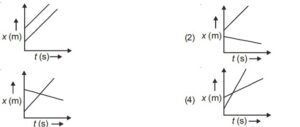A bus begins to move with an acceleration of 1 ms–². A man who is 48 m behind the bus starts running at 10 ms–¹ to catch the bus. The man will be able to catch the bus after
Solution:
Using relative speed, let’s re-calculate with the correct setup:
1. Acceleration of the bus: \( a = 1 \, \text{m/s}^2 \)
2. Initial distance behind the bus: \( d = 48 \, \text{m} \)
3. Speed of the man: \( v_m = 10 \, \text{m/s} \)
4. The equation of motion for the bus after \( t \) seconds:
\[
d_b = \frac{1}{2} a t^2 = \frac{1}{2} \cdot 1 \cdot t^2 = \frac{1}{2} t^2
\]
5. Distance traveled by the man:
\[
d_m = v_m \cdot t = 10t
\]
6. Setting the distances equal considering the man starts 48 m behind:
\[
10t = \frac{1}{2} t^2 + 48
\]
\[
\frac{1}{2} t^2 - 10t + 48 = 0
\]
7. Multiplying by 2:
\[
t^2 - 20t + 96 = 0
\]
8. Using the quadratic formula:
\[
t = \frac{20 \pm \sqrt{20^2 - 4 \cdot 96}}{2}
\]
\[
t = \frac{20 \pm \sqrt{400 - 384}}{2}
\]
\[
t = \frac{20 \pm 4}{2}
\]
\[
t = 12 \, \text{s} \quad \text{or} \quad t = 8 \, \text{s}
\]
the man will catch the bus is 8 seconds.
